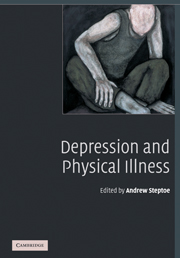Book contents
- Frontmatter
- Contents
- List of contributors
- Preface
- Part 1 Introduction to depression and its determinants
- Part 2 Depression and specific health problems
- 3 Depression and the development of coronary heart disease
- 4 Depression and prognosis in cardiac patients
- 5 The management of depression in patients with coronary heart disease
- 6 Depression and physical disability
- 7 Chronic pain and depression: twin burdens of adaptation
- 8 The interrelationship of depression and diabetes
- 9 Depression and chronic fatigue
- 10 Cancer and depression
- 11 Depression and obesity
- Part 3 Biological and behavioural processes
- Part 4 Conclusions
- Index
- References
9 - Depression and chronic fatigue
from Part 2 - Depression and specific health problems
Published online by Cambridge University Press: 17 September 2009
- Frontmatter
- Contents
- List of contributors
- Preface
- Part 1 Introduction to depression and its determinants
- Part 2 Depression and specific health problems
- 3 Depression and the development of coronary heart disease
- 4 Depression and prognosis in cardiac patients
- 5 The management of depression in patients with coronary heart disease
- 6 Depression and physical disability
- 7 Chronic pain and depression: twin burdens of adaptation
- 8 The interrelationship of depression and diabetes
- 9 Depression and chronic fatigue
- 10 Cancer and depression
- 11 Depression and obesity
- Part 3 Biological and behavioural processes
- Part 4 Conclusions
- Index
- References
Summary
Introduction
This chapter reviews fatigue as a symptom and some of its syndromes, including chronic fatigue syndrome and vital exhaustion. The chapter also reviews the similarities and differences between fatigue and depression. The links include common symptoms, sleep disturbance, physical inactivity and common treatments with both cognitive – behavioural therapy (CBT) and graded exercise therapy. The differences involve aetiology, pathophysiology, nosology and response to antidepressants. Depression and fatigue should be considered as separate phenomena with common presentations and associations.
Epidemiology of fatigue
Fatigue is a common symptom in both the community and primary care. Between 10% and 20% of people in the community, if asked, will admit to feeling abnormally tired at any one time [1]. At the same time, fatigue is distributed continuously within the community, with no point of rarity [2]. Therefore, any cut-off is arbitrary, and the prevalence will vary by definition of fatigue, how the question is asked or the symptom volunteered, and its context; for instance, fewer people volunteer fatigue to their general practitioner (GP). Studies of fatigue reporting to primary-care doctors from Ireland and Holland calculated annual incidences of 6.5 and 5.3 reports per 100 patients, respectively [3, 4]. One study showed that the incidence of the complaint of fatigue and its synonyms (e.g. tired, worn out, exhausted) recorded by GPs in the UK did not change in the 12 years between 1990 and 2001, being reported by 1.5% of GP attenders per annum [5].
Keywords
- Type
- Chapter
- Information
- Depression and Physical Illness , pp. 195 - 210Publisher: Cambridge University PressPrint publication year: 2006



